Customer sentiment analysis: How does it work?

Associate Product Manager, AI

Tags
Share
If you're having one or two customer conversations a day, usually it's pretty easy to keep a pulse on things and know if your customers are generally happy with you (or not).
But what if your company is a little bigger and has a couple more locations... Maybe your team gets tens, or hundreds (or thousands!) of customer calls a day? How can you make sure that you're keeping as many of your customers as happy as possible then?
That's where customer sentiment analysis tools come in.
But beyond just helping you understand and track happy and not-so-happy feelings that your customers have toward you, these can actually do many other interesting things. (Say... competitor analysis.)
We'll get into the specifics of each one in a bit. But first, let's look at the basics: positive and negative customer sentiment.
How to use positive and negative sentiment
Let's face it. Sometimes, customers get upset. Usually, with good reason. And when that happens, you need to be able to sort and organize this type of feedback quickly so that you can make a plan to improve things.
Positive sentiment identifies and highlights whenever the customer says something to indicate that they are very happy or pleased with something.
Example: "We loved the demo, it was super informative."
✨ Dialpad tip:
Dialpad Ai does live sentiment analysis, which is great for both sales and customer support teams. If you manage a sales or support team, you can go through these moments in 1:1 meetings with your reps or share them in a playlist to train new reps on how to handle both positive and negative samples. That means less ramp time for them, and more time for you to focus on more high-value tasks (especially near the end of quarter).
Negative sentiment identifies and highlights whenever the customer says something to indicate that they're frustrated or annoyed with something.
Example: "This isn’t working and it's really frustrating."
✨ Dialpad tip:
For customer support teams, knowing why someone is frustrated or happy is key. And if you're a contact center manager, a live sentiment overview for your team will give you clear cues for when you need to jump in and help on a tough customer call.
3 ways to use customer sentiment to provide a better experience
1. Use real-time sentiment analysis to pinpoint calls that really need help
If you're a call center supervisor, you're probably busy—which means you can't just hop onto every call that might need your help. And you shouldn't have to! This is where a good customer sentiment analysis solution can really make your job easier.
For example, with Dialpad Ai and Supervisor Insights, you can easily see both positive and negative sentiment in your team's active calls. In real time.
Oh, and there's a handy transcription analysis of your agents' calls—that also gets updated in real time.
Y'know, just in case you need to jump in or you've got a newer team member who could use a little help.
It's really easy to use Dialpad Ai. All you have to do is make sure it's turned on, then navigate to the Active Calls tab in your call center dashboard to see any calls marked with "Negative" sentiment:

✨ Dialpad tip:
When negative situations do come up, you can use the live call view to decide whether you need to view the live transcription, listen in, or join to assist on the call.
2. Quickly understand how you're doing over time using customer sentiment analytics
Now for some big picture stuff. Analytics are super important if you're managing a call center (yep, even a smaller one) because they give a birds-eye view of how your team is doing as a whole. (Plus, if there's a serious issue that is causing lots of customer complaints, your analytics are usually where you'll see red flags first.)
If you're not already doing this, it might be helpful to just schedule a reminder every week to take a quick look at your overall customer sentiment analytics.
For instance, here's how your dashboard looks in Dialpad—super clean and easy to see how positive and negative sentiments are trending. You can even see if certain words keep popping up in happy (or... not-happy) customer calls:

This way, you can quickly understand if people are loving a new product feature (or if it's causing issues).
3. Coach your team toward becoming all-stars
Okay, tracking customer sentiment is great and all, but how can you actually use all this sentiment data?
If you're using a contact center platform like Dialpad, there's actually a concrete way to help your agents perform better using that information.
First, you can quickly pull up calls with coachable moments by navigating to your Calls List in the Analytics dashboard and filtering for moments of interest.
This will tell you what customers have been reacting negatively or positively to. For example, you might find that your prospects have been expressing negative sentiments about a competitor—which you can filter just by adding the competitor's name as a keyword.
Now, you could add an RTA (Real Time Assist) card that gives your team useful notes about how your company is better than that competitor:

Depending on how prospects respond to that pitch, you can keep editing and refining it as you get more feedback on these calls.
✨ Dialpad tip:
Managers with a Dialpad Ai Sales license can also filter for calls of interest through the Coaching Center. These calls can then be used for coaching; either in your next 1-1, or by sharing the playlist with your team.
Use customer sentiment analysis to give your team superpowers
The thing is, understanding how your customers are feeling gets harder and harder as your company grows.
Make sure you have a plan for how you keep track of customer sentiment—before your team gets bombarded with hundreds of calls each day.
Of course, we have to end with a plug of Dialpad's artificial intelligence feature, but that's because it really is designed to help you understand customer sentiment more quickly (and more efficiently too). If you're looking for ways to get your team punch above its weight, check it out!
See the power of sentiment analysis first-hand
Want to see first-hand how customer sentiment analysis could work for your team? 👀








